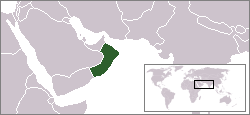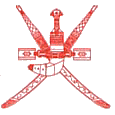Oman
|
|
The Sultanate of Oman is a country in the southwestern part of Asia, on the southeast coast of the Arabian Peninsula. It borders the United Arab Emirates in the northwest, Saudi Arabia in the west, and Yemen in the southwest. The coast is formed by the Arabian Sea in the south and east, and the Gulf of Oman in the northeast.
| |||||
| National motto: none | |||||

| |||||
| Official language | Arabic | ||||
| Capital | Muscat | ||||
| Sultan | Qaboos bin Said Al Said | ||||
| Area - Total - % water | Ranked 82nd 309,500 km² 0% | ||||
| Population - Total (2000) - Density | Ranked 135th 2,622,198 12.3/km² | ||||
| Independence | 1650 (expulsion of the Portuguese) | ||||
| National anthem | Nashid_as-Salaam_as-Sultani | ||||
| Currency | Rial | ||||
| Time zone | UTC+4 | ||||
| Internet TLD | .om | ||||
| Calling Code | 968 | ||||
| Contents |
History
Main article: History of Oman
The region of Oman was once known by its Sumerian name Magan. Oman constituted one of the Satrapies of the Persian Empire. It was incorporated by that empire around 563 BC.
After Oman’s development in the 3rd century BC, the Persians developed an empire in the 4th century BC. This empire lasted until the 7th century AD. In the beginning of the 1st Century AD Arab tribes began to settle into Oman. In 632 the Persian Empire lost power and Oman’s Arab character was established.
In the year 751 the Ibadi Muslims made an imamate in Oman. An imamate is a country ruled by an imam, or any of various rulers who claim that they have descent from the prophet Muhammad. These leaders would exercise spiritual leadership over the country. The Ibadi Muslims are considered by other Muslims to be a branch of the Kharijites. The Kharijites is the earliest Muslim sect which was originally among the supporters of Ali, the fourth caliph of Islam. A caliph is very similar to an imam in definition. The Ibadi imamate survived until the mid-20th Century.
Oman has been a centre for traders for centuries. In 1508, the main port, Muscat, was captured by the Portuguese, who held it until it was taken by the Ottomans in 1659. These were driven out in 1741, when the present line of sultans was formed by Ahmed ibn Said.
Fortoman.jpg
In the early 19th century, Oman grew to a major power, having possessions in Baluchistan and Zanzibar, but these were gradually all lost. In 1891, Oman became a British protectorate, which lasted until 1971. The year prior, sultan Said ibn Taimur had been ousted by his son, sultan Qaboos bin Said Al Said, (ruled 1970 - ). Qaboos has since greatly improved the economic situation of the country, remaining in peace with all other countries in the Middle East. In 1996 the sultan issued a decree promulgating a new basic law that clarifies the royal succession, provides for a bicameral advisory council with some limited legislative powers and a prime minister, and guarantees basic civil liberties for Omani citizens. Military bases in Oman were used (2001) by U.S. forces involved in ground raids against Afghanistan and Osama bin Laden. In 2003 the lower house of the advisory council was freely elected for the first time.
Politics
Main article: Politics of Oman
Qaboospalace.jpg
Chief of state and government is the hereditary sultan (Qaboos of Oman), who appoints a cabinet to assist him. In the early 1990s, the sultan instituted an elected advisory council, the Majlis ash-Shura, though only a small part of the Omanis were elegible to vote. Universal suffrage for those over 21 was instituted on 4 October 2003. Over 190,000 people (74% of those registered) voted to elect the 83 seats. Two women were elected to seats.
Although the sultan functions basically as an absolute Ruler, he has the approval of most of the Omanis: in his 30 years of government he has greatly improved the situation in the country. The governmental system is very gradually developing in the direction of some democracy.
Subdivisions
Main article: Subdivisions of Oman
Oman is divided into eight regions (mintaqah). These regions are subdivided into smaller districts (wilayat, singular wilaya).
- Ad Dakhiliyah
- Al Batinah
- Al Wusta
- Ash Sharqiyah
- Az Zahirah or Ad Dhahirah
- Masqat (more usually identified in English as Muscat)
- Musandam
- Dhofar
Geography
Main article: Geography of Oman
A vast desert plain covers most of central Oman, with mountain ranges along the north and southeast coast, where the countries main cities are also located: capital city Muscat, Matrah and Sur in the north, and Salalah in the south. Oman's climate in the interior is hot and dry, but humid along the coast.
Dabba.jpg
The peninsula of Musandam which has a strategic location on the Strait of Hormuz, is separated from the rest of Oman by the United Arab Emirates. Not all of Oman's borders with that country are well defined. Oman has one exclave inside UAE territory, the town of Madha. Oman is considered to be one of the fifteen states that comprise the so-called "Cradle of Humanity".
Economy
Main article: Economy of Oman
The economy of Oman is dominated by its dependence on crude oil. A joint venture called IPC drilled a number of dry holes from 1956 onwards though the logistics of doing this were extremely difficult due to lack of any transportation infrastructure.
Bustan.jpg
A lack of success, combined with worsening logistical problems and a glut of oil on the world market, led most of the partners to withdraw from the venture in 1960. Only Royal Dutch/Shell and Partex opted to remain in Oman to continue the search for oil. They struck oil at Yibal in 1962 at a site just some few hundreds of metres from the last dry hole.
In June 1967, the Compagnie Française des Pétroles rejoined the partnership by taking over 10% of Partex's equity share, resulting in the following shareholding: Shell 85%, Compagnie Francaise des Petroles 10% and Partex 5%. The company changed its name to Petroleum Development (Oman). Shortly followed by the first export of Omani oil on 27 July 1967.
On 1 January 1974 the Government of Oman acquired a 25% shareholding in the Petroleum Development (Oman); half a year later they increased it to 60%, backdated to the beginning of the year. As a result foreign shareholding in PD(O) was now made up of Royal Dutch/Shell (34%), Compagnie Française des Petroles (now Total)(4%) and Partex (2%).
In a Royal Decree of 15 May 1980, the company was registered as a limited liability company (LLC) under the name Petroleum Development Oman (without parentheses).
Today Oman produces around 700,000 barrels (110,000 m³) of oil per day and there have been significant discoveries of natural gas and development of liquefied natural gas terminals. Oil represents about 90% of Oman's exports.
The income generated was quickly deployed into building infrastructures of roads, schools, hospitals, water and electricity generating plants. All of this activity has made Oman a major success story for economic growth despite being the only oil-producing nation in the middle east that is not a member of OPEC.
Oman's economic performance improved significantly in 2000 due largely to the upturn in oil prices. The government is moving ahead with privatization of its utilities, the development of a body of commercial law to facilitate foreign investment, and increased budgetary outlays. Oman continues to liberalise its markets and joined the World Trade Organization in November 2000. GDP growth improved in 2001 despite the global economic slowdown.
Demographics
Main article: Demographics of Oman
Qaboosemosque.jpg
Oman is the world's easternmost Arabian country. The majority of the Omanis are Arabs, although there is a sizable Baluchi minority (an Iranian people). As in most other Arab countries, a large number of foreign laborers lives here, mostly from India, Pakistan and Iran. The official language is Arabic, but the minorities speak their own languages. A non-Arabic Semitic language is spoken in Dhofar.
Islam is the predominant religion, mostly Ibadhi Muslims with a Sunni population in Dhofar; many of the Indians practise Hinduism.
Culture
Main article: Culture of Oman
Although Oman is a modern country, western influences are restricted; the Ibadhi form of Islam is very strict in comparison with Sunni Islam and Shi'a Islam.
Oman is famous for its khanjar knives(dagger).
Miscellaneous topics
- Communications in Oman
- Transportation in Oman
- Military of Oman
- Foreign relations of Oman
- List of cities in Oman
External links
- Omani Ministry of Information (http://www.omanet.om/)
- Petroleum Development Oman (http://www.pdo.co.om/)
- Oman by Lonely Planet (http://www.lonelyplanet.com/destinations/middle_east/oman/history.htm)
- Andy Carvin's Oman Photo Gallery (http://www.edwebproject.org/oman-dubai/)
- Arab Gateway - Oman (http://www.al-bab.com/arab/countries/oman.htm)
- BBC News Country Profile - Oman (http://news.bbc.co.uk/2/hi/world/middle_east/country_profiles/791892.stm)
- CIA World Factbook - Oman (http://www.cia.gov/cia/publications/factbook/geos/mu.html)
- Library of Congress Country Study - Oman (http://lcweb2.loc.gov/frd/cs/omtoc.html) data as of January 1993
- LookSmart - Oman (http://search.looksmart.com/p/browse/us1/us317916/us559898/us560105/us560116/) directory category
- Open Directory Project - Oman (http://dmoz.org/Regional/Middle_East/Oman/) directory category
- Yahoo! - Oman (http://dir.yahoo.com/Regional/Countries/Oman) directory category
| Countries and Territories in Southwest Asia |
|
Afghanistan | Armenia | Azerbaijan | Bahrain | Cyprus | Gaza Strip | Georgia | Iran | Iraq | Israel | Jordan | Kuwait | Lebanon | Oman | Qatar | Russia | Saudi Arabia | Syria | Turkey | United Arab Emirates | West Bank | Yemen |
| Countries and territories in the Middle East |
|---|
| Bahrain | Cyprus | Egypt | Gaza Strip | Iran | Iraq | Israel | Jordan | Kuwait | Lebanon | Oman | Qatar | Saudi Arabia | Syria | Turkey | United Arab Emirates | West Bank | Yemen |
bg:Оман bs:Oman ca:Oman cy:Oman da:Oman de:Oman et:Omaan es:Omán eo:Omano fr:Oman gl:Omán - عُمان ko:오만 hr:Oman id:Oman it:Oman he:עומן ks:ओमान lt:Omanas ms:Oman zh-min-nan:Oman nl:Oman nds:Oman ja:オマーン nb:Oman pl:Oman pt:Omã ru:Оман sa:ओमान sk:Omán sl:Oman fi:Oman sv:Oman th:ประเทศโอมาน uk:Оман zh:阿曼


